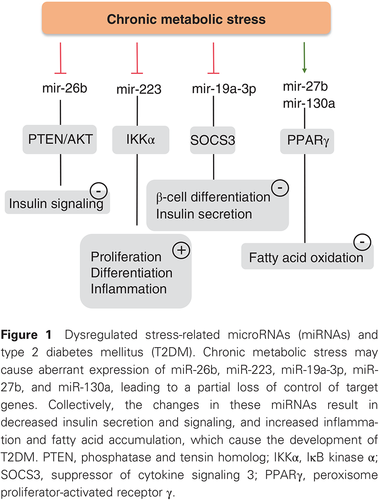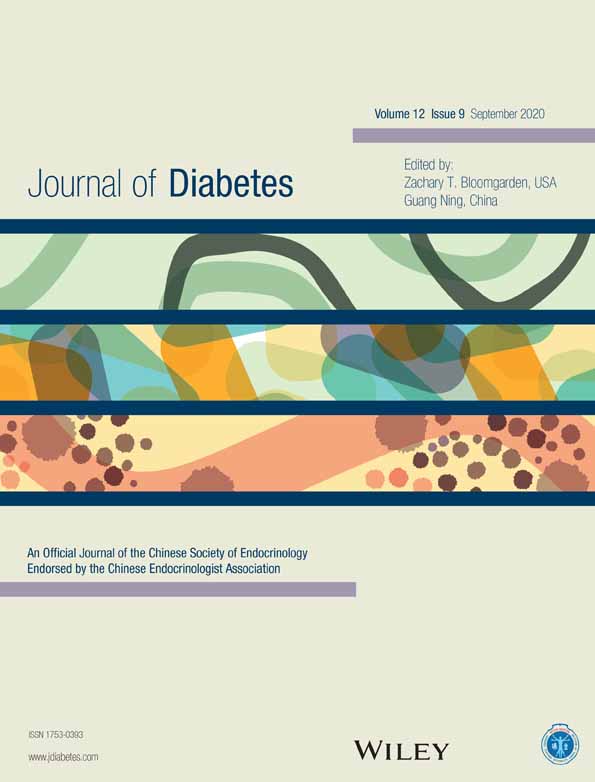MicroRNAs in type 2 diabetes mellitus: Important for the pathogenesis but uncertain as biomarkers
2型糖尿病中的miRNA:病理发生过程中的重要参与者, 但尚未明确能否作为生物标记物
Jingwei Yu
Shenzhen University Diabetes Center, Shenzhen University Health Science Center, Department of Medicine, Shenzhen University, Shenzhen, China
Department of Biology, Guangdong Pharmaceutical University, Guangzhou, China
Search for more papers by this authorWen Su
Shenzhen University Diabetes Center, Shenzhen University Health Science Center, Department of Medicine, Shenzhen University, Shenzhen, China
Search for more papers by this authorXiaoyan Zhang
Advanced Institute for Medical Sciences, Department of Physiology and Pathophysiology, Dalian Medical University, Dalian, China
Search for more papers by this authorFeng Zheng
Advanced Institute for Medical Sciences, Department of Physiology and Pathophysiology, Dalian Medical University, Dalian, China
Search for more papers by this authorCorresponding Author
Youfei Guan
Advanced Institute for Medical Sciences, Department of Physiology and Pathophysiology, Dalian Medical University, Dalian, China
Email: [email protected]Search for more papers by this authorJingwei Yu
Shenzhen University Diabetes Center, Shenzhen University Health Science Center, Department of Medicine, Shenzhen University, Shenzhen, China
Department of Biology, Guangdong Pharmaceutical University, Guangzhou, China
Search for more papers by this authorWen Su
Shenzhen University Diabetes Center, Shenzhen University Health Science Center, Department of Medicine, Shenzhen University, Shenzhen, China
Search for more papers by this authorXiaoyan Zhang
Advanced Institute for Medical Sciences, Department of Physiology and Pathophysiology, Dalian Medical University, Dalian, China
Search for more papers by this authorFeng Zheng
Advanced Institute for Medical Sciences, Department of Physiology and Pathophysiology, Dalian Medical University, Dalian, China
Search for more papers by this authorCorresponding Author
Youfei Guan
Advanced Institute for Medical Sciences, Department of Physiology and Pathophysiology, Dalian Medical University, Dalian, China
Email: [email protected]Search for more papers by this author
References
- 1Bartel DP. MicroRNAs: Genomics, biogenesis, mechanism, and function [reprinted from Cell 2004; 116: 281–297]. Cell. 2007; 131: 11–29.
- 2Bernstein E, Kim SY, Carmell MA et al. Dicer is essential for mouse development. Nat Genet. 2003; 35: 215–217.
- 3Karolina DS, Tavintharan S, Armugam A et al. Circulating miRNA profiles in patients with metabolic syndrome. J Clin Endocrinol Metab. 2012; 97: E2271–E2276.
- 4Kalis M, Bolmeson C, Esguerra JL et al. Beta-cell specific deletion of Dicer1 leads to defective insulin secretion and diabetes mellitus. PLoS One. 2011; 6: e29166.
- 5Bentwich I, Avniel A, Karov Y et al. Identification of hundreds of conserved and nonconserved human microRNAs. Nat Genet. 2005; 37: 766–770.
- 6Belgardt BF, Ahmed K, Spranger M et al. The microRNA-200 family regulates pancreatic beta cell survival in type 2 diabetes. Nat Med. 2015; 21: 619–627.
- 7Chen X, Ba Y, Ma L et al. Characterization of microRNAs in serum: A novel class of biomarkers for diagnosis of cancer and other diseases. Cell Res. 2008; 18: 997–1006.
- 8Ortega FJ, Mercader JM, Moreno-Navarrete JM et al. Profiling of circulating microRNAs reveals common microRNAs linked to type 2 diabetes that change with insulin sensitization. Diabetes Care. 2014; 37: 1375–1383.
- 9Liang YZ, Li JJ, Xiao HB, He Y, Zhang L, Yan YX. Identification of stress-related microRNA biomarkers in type 2 diabetes mellitus: A systematic review and meta-analysis. J Diabetes. 2018. https://doi.org/10.1111/1753-0407.12643.
10.1111/1753-0407.12643 Google Scholar
- 10Zhuang G, Meng C, Guo X et al. A novel regulator of macrophage activation: MiR-223 in obesity-associated adipose tissue inflammation. Circulation. 2012; 125: 2892–2903.
- 11Zampetaki A, Kiechl S, Drozdov I et al. Plasma microRNA profiling reveals loss of endothelial miR-126 and other microRNAs in type 2 diabetes. Circ Res. 2010; 107: 810–817.
- 12Xiao F, Yu J, Liu B et al. A novel function of microRNA 130a-3p in hepatic insulin sensitivity and liver steatosis. Diabetes. 2014; 63: 2631–2642.
- 13Busch S, Auth E, Scholl F et al. 5-Lipoxygenase is a direct target of miR-19a-3p and miR-125b-5p. J Immunol. 2015; 194: 1646–1653.
- 14Li Y, Luo T, Wang L, Wu J, Guo S. MicroRNA-19a-3p enhances the proliferation and insulin secretion, while it inhibits the apoptosis of pancreatic beta cells via the inhibition of SOCS3. Int J Mol Med. 2016; 38: 1515–1524.
- 15Chen Y, Song YX, Wang ZN. The microRNA-148/152 family: Multi-faceted players. Mol Cancer. 2013; 12: 43.
- 16Zhu H, Leung SW. Identification of microRNA biomarkers in type 2 diabetes: A meta-analysis of controlled profiling studies. Diabetologia. 2015; 58: 900–911.
- 17Alpers CE, Hudkins KL. Mouse models of diabetic nephropathy. Curr Opin Nephrol Hypertens. 2011; 20: 278–284.
- 18Zampetaki A, Willeit P, Burr S et al. Angiogenic microRNAs linked to incidence and progression of diabetic retinopathy in type 1 diabetes. Diabetes. 2016; 65: 216–227.
- 19Shantikumar S, Caporali A, Emanueli C. Role of microRNAs in diabetes and its cardiovascular complications. Cardiovasc Res. 2012; 93: 583–593.
- 20Kantharidis P, Wang B, Carew RM, Lan HY. Diabetes complications: The microRNA perspective. Diabetes. 2011; 60 (7): 1832–1837.
- 21Putta S, Lanting L, Sun G, Lawson G, Kato M, Natarajan R. Inhibiting microRNA-192 ameliorates renal fibrosis in diabetic nephropathy. J Am Soc Nephrol. 2012; 23: 458–469.
- 22Yang Y, Xiao L, Li J, Kanwar YS, Liu F, Sun L. Urine miRNAs: Potential biomarkers for monitoring progression of early stages of diabetic nephropathy. Med Hypotheses. 2013; 81: 274–278.





